Fourth Storey
Sacred Light Hall Inner Chamber Topics
Fourth Storey Topics
Sacred Buddha Tooth Relic Stupa
Location Description
The 4th floor Inner Chamber is the repository of the Sacred Buddha Tooth. The gold Sacred Buddha's Tooth Relic Stupa is the center of focus in this magnificent and elegant room. There is a painting of the Vairocana Mandala above this Stupa, with carvings of 36 dragons below it. Gilt flower garland offering lamps and a jewel netting cordons the ceiling. There are paintings of 20 Heavenly Devas keeping watch and the floor is lined with gold tiles.
Sacred Buddha's Tooth Relic Stupa in Buddha Tooth Relic Temple & Museum
Beginning from the top, there is a large crystal above 7 parasols. There are jewelled bangles from Myanmar around the last parasol. The main dome of the stupa has a reverse lotus at the top. Below this are 189 sets of Stupa gems collection of emeralds and rubies. Below this are the 35 Confession Buddhas. The dome ends on a circular base with engraved floral motifs and sits on a square platform featuring scenes from the life of the Buddha.
About Sacred Buddha's Tooth Relic Stupa
The Sacred Buddha’s Tooth Relic Stupa statue is modeled after two similar Gandharan period stone stupas at the museums of New Delhi and Kolkata. The dome is crowned by the 7-tiered parasol depicting royalty and the cosmic connection between heaven and earth.
Buddha Maitreya

The Buddha Maitreya statue at the Stupa doorway adopts the Bhadrasana (auspicious) posture (European seating position), with each feet on a lotus, symbolic of royalty, on the Varjasana (diamond) throne, as if all ready to descend to this world, to fulfill His destiny as the Future Buddha. Both hands are in the Dharmachakra (Turning of the Wheel) mudra, symbolising His Teachings to sentient beings in the heaven. A round aureole radiates behind His head. The Maitreya statue required 15 kgs of gold.
Stupa Gems

According to the Lotus Sutra, a seven-gem studded stupa appeared in front of Buddha while He preached the Lotus Sutra. It rose from the ground growing towards the sky and having 5 thousand railings, thousands of rooms, with uncountable number of umbrellas, with many treasures like gold, silver, pearls, roses, etc and fragrance from the four sides.
Inspired by the sutra, the Sacred Buddha Tooth Relic Stupa is decorated with gem stones such as rubies, emeralds, etc. Venerable Shi Fa Zhao specially engaged overseas craftsmen, sorting out the rubies, emeralds and diamonds for the design of these Stupa gems. These specially crafted gems collection were inserted into positions on the gold Stupa. Together they enhance and beautify the Buddha Tooth Relic Stupa.
The Sponsorship of each stupa gems collection was $3,000 with 201 sets fully adopted.
35 Confession Buddhas
On the first tier of the Stupa from the base, lie the bas reliefs of the intricately carved Thirty-Five Confession Buddhas in pure gold. These Thirty-Five Confession Buddhas are Buddhas that had gained enlightenment before Buddha Sakyamuni.
This grouping of the 35 Buddhas is recorded in the Definite Vinaya Sutra. The sutra was translated by Dharmaraksa竺法护, a renowned Indian scholar monk and actually derived from the Upali Section of the Collection of Precious Jewels Sutra (Sanskrit: Maharatnakuta Sutra, Tibetan: könchog tsegpa). Amoghavajra retranslated the pertinent portion of the text and called it the 'Worship and Penitential Text of the 35 Buddhas' Names'. This text became widely known as the Mahayana Sutra of the Three Superior Heaps (Sanskrit: Triskandhadharmasutra). The Three Heaps refer to the 'heaps' or collections of confession, dedication and rejoicing.
Atisha (980-1054 CE) explained that although all Buddhas have the power to protect living beings from suffering, due to the special prayers made by these 35 Buddhas when they were Bodhisattvas, they have uncommon abilities and strong karmic links to assist beings of this world.
In his Guide to the Bodhisattva's Way of Life (Sanskrit: Bodhisattvacaryavatara), Shantideva, the 8th century Buddhist master, advises that:
[One] should practise the Sutra of the Three Heaps
Three times each day and three times each night,
And, with reliance on the Three Jewels and bodhichitta,
Purify non-virtues and downfalls.
- Bodhisattvacaryavatara 5:98 (Shantideva 2002, 63)
Due to the importance and significance given to Bodhisattvacaryavatara by past and present Tibetan masters, the practice of the 35 Buddhas has remained to this day almost exclusively among Himalayan Buddhists. For example, Je Tsongkhapa (1357-1419 CE) purportedly performed 100,000 prostrations in front of each of the 35 Buddhas, making a total of 3.5 million prostrations. The stone where he performed his prostrations in Wölka still bears the imprint of his body. As a result of his sincere and diligent practice, he received a pure vision of them and his vision, written down in his Practice of the Thirty-five Buddhas and a Description of the Deities' Bodies, consititute one of three major systems of representations of the 35 Buddhas. The other two are: (1) without hand attributes (which may have originated from the Nyingma tradition) and (2) a so-called 'Nagarjuna' system [not necessarily the more well-known Nagarjuna]).
It is said that Mahayana practitioners who frequently perform the worship and penitence during the six times of the day (i.e. dawn, noontime, dusk, early night, midnight and late night) will achieve great merits. They will be cleansed of karmic obstructions and serious guilt, and will attain whatever samadhi, deliverance and spiritual level they seek in this life.
Together with the practice of Vajrasattva, the 35 Confession Buddhas practice is one of the most important purification practice of Tibetan Buddhists which consists of generating the four opponent powers essential for successful purification of regret, reliance, opponent force and promise. The power of the opponent force here entails performing full-length prostrations to each of the Buddhas.
Attributes of the 35 Confession Buddhas are as follows:
It appears that some listings in the Chinese canon differs in adding a 'Buddha Sariputra' (离垢佛) as the 12th Buddha and omits 'Buddha Clearly Knowing through Enjoying Pure Radiance' (Sanskrit: Brahma-jyotir-vikrīḍitābhijña, Chinese: 清净光游戏神通智佛), the 24th Buddha.
The Sponsorship of each Confession Buddha is 2 kgs of gold, fully adopted.
The Gold Panels of Eight Aspects of the Buddha's Life
At the sides of the Stupa's square platform are 8 gold panels with engravings depicting various scenes of Buddha Shakyamuni's life, starting with the Dream of Queen Maya and ending with the Great Parinirvana. These panels are executed in the traditional style of the Gandharan period.
The scenes of the Buddha's life from beginning to end, revolving around His Enlightenment are known as the Eight Aspects of the Enlightenment Story (or the "Eight Aspects of Manifestation") Sutra, with His Enlightenment being the most important.
1. Descent from Tusita:
Having made His abode in the Tusita Heaven for 4,000 years, the Bodhisattva Prabhapala (i.e. the Buddha prior to Enlightenment) rode upon a white six-tusked elephant and incarnated in our world. He entered the womb of Queen Maya at the residence of King Suddhodana of the Shakya kingdom in Kapilavatthu.
2. Birth:
As Queen Maya's delivery date drew near, she had to return to her maternal home to give birth in accordance with the customs of the time. While passing by the Lumbini garden on her way, she gave birth to Prince Siddhartha Gautama (this being the secular name of the Buddha Shakyumuni) under an asoka tree. Nine nagas spewed water to bathe the newborn Prince, who immediately walked 7 steps, pointed at the heaven with one finger, and at the earth with another, saying, "I alone am Supreme, above and below heaven."
3. Life in the Palace:
The Prince studied various arts and sciences when he was young. Although he lived in prosperity and nobility, his mind was constantly serene. Once, after wandering through the four gates and seeing the sick, the old, the dead, and some spiritual practitioners, he began to have the desire to leave the secular world behind and pursue spiritual truth.
4. Renunciation:
The Prince's desire to renounce the secular life was so strong that King Suddhodana could not persuade him otherwise or stop him. Accompanied by his attendant Chandaka, he eventually rode a horse out of the city. He shaved off the hair on his head and face, put on a sramana's robe, sent Chandaka back to the palace, and subsequently went to the snowy mountains to practise austerities.
5. Subduing the Mara:
After 6 years of austerities, the Prince emerged from the snowy mountains. He took a bath in the Nairanjana river, ate some milk rice offered by a herdswoman, and sat down cross-legged with upturned soles under a bodhi tree, vowing never to get up again until he has attained perfect wisdom. Even though Mara sent his daughters to undermine the Prince's spiritual aspiration, they were subdued by him.
6. Attaining Enlightenment:
The Prince went into a deep meditative state under the Bodhi tree, exploring the Truth concerning the Universe and life. Finally, on the night of the 8th day of the 12th month, he removed all his mental defilements and their imprints, looked upon a bright star and attained Enlightenment. Having acquired unsurpassable Perfect and Universal Wisdom, he attained full enlightenment and became Buddha Shakyamuni.
7. Turning the Wheel of Dharma:
After His Enlightenment, Buddha Shakyamuni gave sermons for 45 years including 3 Turns of the Dharma Wheel, the 4 Noble Truths, 12 Nidanas, 37 Bohhyangas, 3 Dharma Signs, Eightfold Noble Path, 6 Perfections etc. to release all the sentient beings from samsara. As His followers grew, He set up the Buddhist organization, namely the Sangha―the Bhiksus, the Bhiksunis; and at the same time gave the lay devotees (Kulapati) equivalent status. With the increasing numbers of lay devotees, they became the main donors and patrons in society supporting Buddhism.
8. Maha Parinirvana:
When Buddha Shakyamuni turned 80 years old, He passed into Nirvana between two trees in a sala grove in the rural area of Kusinara city. After Nirvana, His Teachings, called Sutras, Pitakas and Sastras, were memorised, recorded and published by his disciples and passed from one generation to the next. There were a total of 12 collections, and they became the most important records of civilization for mankind, like the torch of the wisdom, brightening up the lives of generations after generations and guiding countless lives towards deliverance.
Asoka Towers
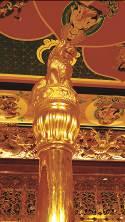
There are 4 Asoka pillars (columns or towers) with the Asoka lions at the top, at each corner of the platform. The lion stands for King Asoka's aristocracy and imperial power. The roar of the lions is akin to the propagation of Buddha Dharma in all directions, reaching far and wide.
About Stupas
A stupa (Sanskrit: स्तूप, stūpa; Sinhalese: ස්ථූපය; Pāli: थुप "thūpa", literally meaning "heap") is a mound-like structure containing Buddhist relics, typically the remains of Buddha, used by Buddhists as a place of worship. Stupas are an ancient form of mandala.
Development of Sacred Buddha's Tooth Relic Stupa
The Sacred Buddha's Tooth Relic Stupa represents the constant abiding of the inconceivable Dhammakaya, the Buddha's Holy Mind. To offer precious gold to the Buddha's sacred tooth relic is to accord Him the highest respect and devotion. Every kind thought and act of giving brings incredible positive karmic results especially making offerings to the Buddha. As stated in 'Eight Aspects of Manifestation' sutra, "whosoever makes offerings to the sacred relics will be born in the heavenly realms and be liberated from all suffering".
Design
Venerable Shi Fa Zhao felt strongly that as the Buddha was from India, the Sacred Stupa should be of Indian design. After much research, he decided upon a combination of 2 ancient Gandharan stone stupas at the New Delhi and Kolkata museums.
The Loriyan Tangai Stupa
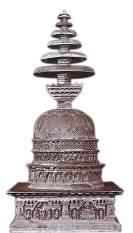

Known as the Loriyan Tangai Stupa (above; elevation and plan from Le 2010, 177) and probably dates from the 2nd Century CE, this is the first inspiration for the Sacred Stupa. Currently displayed at the Indian Museum in Kolkata, it is an excellent example of mature Gandharan stupa styles. Capped with 7 chattras, its façade highlights a relief panel of the Buddha with 2 followers. A simple overlapping leaf motif pattern covers the hemispherical dome followed by a tier of abstract squares with double 'X' patterns. This is followed by a 2nd tier of alternating small squares motifs. Below this is a row of semi-abstract relief of standing figures and trees. Sitting just above the base is a tier of seated meditating buddhas in inverted 'U'-shaped niches. The square base features pseudo-Corinthian pilasters and dentils with scenes from the life of Buddha. A similar stupa was sold at Christie's Art d'Asie, sale 5598, on 8 June 2010 (lot 420).
Scholars believe that, based on evidence gathered from excavations at the Gandharan monastery site, Takht-i-bahi (1st-5th centuries CE) in Mardan valley, Pakistan, that its main stupa most likely resembles the Loriyan Tangai Stupa but much taller at three-stories high (illustration above from Tissot 1993, 47; below from Le 2010, 56).
The Stupa with Lion Capital Columns

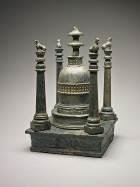

The second inspiration for the Sacred Stupa is a type of stupa exemplified by the Miniature Stupa from the James W. and Marilynn Alsdorf Collection, previously exhibited at the The Art Institute of Chicago (above, see Pal, 76, cat. 92). Another such stupa in a private collection omits the central band of grid-like railing feature in the central body but is otherwise almost identical (below, see Jongeward, 76, fig. 3.27).
The unique feature of this type of stupa is the placement of four lion-topped pillars - more commonly known as Asoka columns (see above) - in each corner of the plinth. Baring a personal inspection, it may be surmised that the columns themselves are moveable: for example, the stupa from the Alsdorf Collection has been separately photographed with the lions facing inwards as well as outwards. A Gandharan relief panel (shown below) indicates that these miniature stupas are most likely replicas of larger ones constructed within Gandharan viharas.
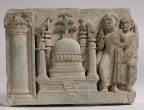
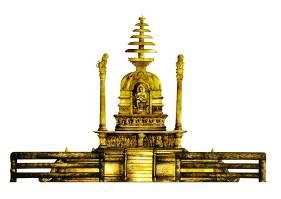
Ven Shi FaZhao was introduced to Professor Amnuay Kantian from the Faculty of Fine Arts, Chiangmai University, Thailand. After the briefing by Ven Shi Fa Zhao, he then developed the first Stupa design.
The design of the Maitreya Buddha was based on the Buddha statue from Candi Mendut, near Borobudur, Indonesia.
The design of the 8 panels about the Life of the Buddha in Gandhara art was quite challenging. Much research and books were collected to develop accurately these stories in Gandhara art. We used extensively the detailed line drawings from a Japanese translation of the book, "Gandhara" by Francine Tissot, Librarie Adrien Maisonneuve, 1985, (ISBN 4-8087-0605-9 C3071, printed by Tokyo Bijutsu, 1993). Extensive discussions and numerous drafts were made before final production.
Model
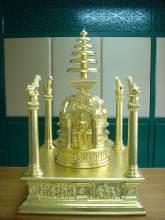
The drawings were used to developed a small model, which was shown to the public during the 2004 Sacred Buddha Tooth Relic Exhibition at Singapore Expo. Thereafter, we commenced collecting gold for the construction of the Stupa.
Collection of Gold

The gold collected was from the devotees and public's personal contribution of gold in the form of rings, chains, bars; and any other precious jewellery such as gemstones or jade. The quantity is not important. What matters is the motivation of giving. The numerous jewelry collected was then sent for refining to 99.99 pure gold kilo bars.
Search for Construction Company

After which, we approached many craftsmen in Thailand, Nepal and China, but due to the size of the Stupa, most were not keen. Fortunately we met Mr Shi Seng Bing of Shanghai Kangyu Enterprise, who was interested and determined to develop the Stupa. After many exhaustive rounds of deliberations, presentations, negotiations and draft drawings, the final design was approved.
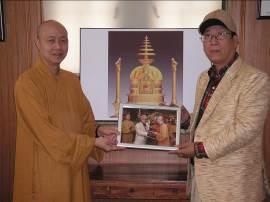
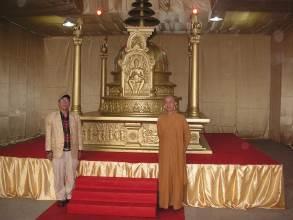
Shanghai Kangyu Enterprise developed a full scale model which was unveiled to Ven Shi FaZhao in October 2005.
Gold-melting Ceremony
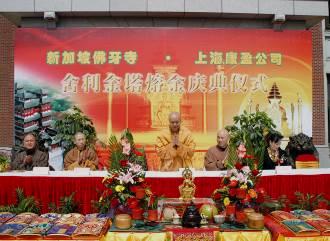
A special on-site Stupa blessing ceremony and the gold melting ceremony to mark the commencement of Stupa construction was held on 14 March 2006, attended by numerous eminent monks from China, donors and staff.
During the Gold-melting Ceremony for the Buddha Tooth Relic Stupa, Ven. Shi Fazhao spoke on the Chairman's podium in person. He gave thanks for the Buddha's blessings and the support of many, and prayed that the forging of the Buddha Tooth Relic Stupa would be a success. Merits gained from this were to be directed back to our countries, so that our nations may be strong and prosperous, and the people living in peace and happiness.
Spring is the time for planning for the year ahead, as well as the season of beautifully blooming flowers, great weather and picturesque natural scenery. In order to pray for the smooth completion of the forging of the Buddha Tooth Relic Stupa, Ven. Shi Fazhao led a group to visit the Shanghai company that is carrying out the work. He conducted an on-site ritual of blessing and purification on 14th March 2006. More than a hundred monastic guests were invited. In addition, an equally large group of devotees who went along did not miss out on the joy of the Dharma in this either.
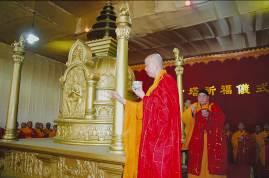

With the preparations for the construction, the gold bars were then specially shipped under international security firm Brinks to Shanghai Kangyu Enterprise foundry and used to construct the Stupa to enshrine the Sacred Buddha's Tooth.
At Shanghai Kangyu foundry, a dedicated special room was developed for the production of the Stupa. The craftsmen were specially selected with strict security and quality control procedures established.
Final adjustments were made to the various parts of the Stupa, including the Buddha Maitreya statue.

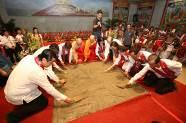
With further fine-tuning by Ven Shi Fa Zhao, a second full size model was made and shipped to Singapore in January 2006 and placed at our Sago Lane exhibition site.
The Stupa Sumeru Vault sealing ceremony was held on 1 October 2006 to prepare for the arrival of the Stupa.
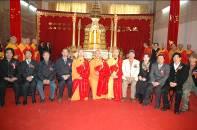
With the speedy completion, Ven Shi FaZhao and numerous Sangha attended the blessing ceremony for the acceptance of the completed Stupa at Shanghai on 27 November 2006.


The Stupa was then packed for shipping to Singapore, arriving on 9 December 2006, where it was lifted onto the fourth floor of the Temple in a very complex operation involving two 50-tonnes cranes.

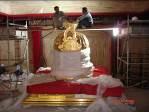
The Shanghai Kangyu team then spent 5 days to install the Stupa. The Stupa was consecrated on 24 December 2006, after which the renovation works for the Inner Chamber proceeded.
The final Stupa weighed 3.5 tonnes consisting of a main structure of stainless steel, a bronze skeleton and a skin of pure gold. It is 3.5 meters in height and XXX meters in width. The total amount of gold used to build this stupa was 320 kg, valued at $XX million at December 2008 gold price.
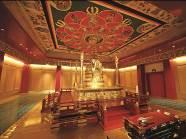
Stupa Consecration Ceremony
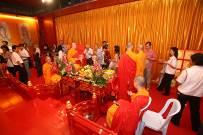
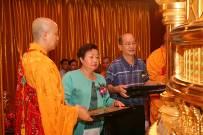
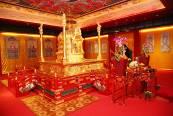
This was held on 24 December 2006 to install the 35 Confession Buddhas and Stupa Gems and was the first time that many of our devotees had seen the Stupa. Many were awed and inspired.
Stupa Blessing Ceremony
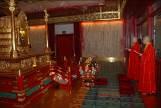
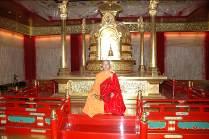
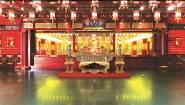
As part of our preparations for the Official Opening, from 1 to 7 May 2007 we conducted a 24-hour blessing ceremony.
Buddha Tooth Relic Temple & Museum - Sacred Buddha's Tooth Relic Stupa Ceremonies
Every year, for 3 days, during the Chinese New Year and Vesak Day celebrations, the Sacred Buddha Tooth is received by President and Abbot, Venerable Shi Fa Zhao from the Sacred Stupa and placed on a special platform close to the viewing glass, for the public to have a special opportunity for veneration.
Bibliography:
John S. Strong, Relics of the Buddha, Princeton University Press, 1948, ISBN 0-691-11764-0,
Borobudur, Prayer in Stone, Editions Didier Millet, 1990, ISBN 2-87868-004-9, pgs 40, 41
Francine Tissot, Gandhara, Librarie Adrien Maisonneuve, 1985, ISBN 4-8087-0605-9 C3071, printed by Tokyo Bijutsu, 1993.
Gyatso, Geshe Jampa. 1996. Everlasting Rain of Nectar: Purification Practice in Tibetan Buddhism. Boston, Mass.: Wisdom Publications.
Gyatso, Geshe Kelsang. 1991. The Bodhisattva Vow: The Essential Practices of Mahayana Buddhism. London: Tharpa Publications.
Shantideva. 2002. Guide to the Bodhisattva's Way of Life. Translated by Neil Elliot. Ulverston, England: Tharpa Publications.
Le, Huu Phuoc. 2010. Buddhist Architecture. Grafikol.
監修星雲大師 ; 委員慈莊 ... et al. ; 主編慈怡。1988。《佛光大辭典》。佛光文化事業有限公司,Vol. 1, 第515-516頁。
フランシーヌ ティッソ Tissot, Francine (原著)。前田 龍彦 (翻訳), 佐野 満里子 (翻訳)。1993。「Gandhâra 図説 ガンダーラ―異文化交流地域の生活と風俗」。Tokyo:東京美術。
Pal, P. 1997. A Collecting Odyssey: Indian Himalayan, and Southeast Asian Art from the James and Marilynn Alsdorf Collection. New York, N.Y.: Art Institute of Chicago in association with Thames and Hudson.
Jongeward, David, Elizabeth Errington, Richard Salomon and Stefan Baums. 2012. Gandharan Buddhist Reliquaries. Seattle: Early Buddhist Manuscripts Project.
Websites:
Stupa - Wikipedia, the free encyclopedia
Sanchi - Wikipedia, the free encyclopedia
Himalayan Art: Subject: Thirty-five Confession Buddhas. Accessed 19 February 2013.
35 Confessional Buddhas | Tsem Rinpoche's Resources. Accessed 14 February 2013.
三十五堕忏佛忏悔文_百度百科。Accessed 18 February 2013.






